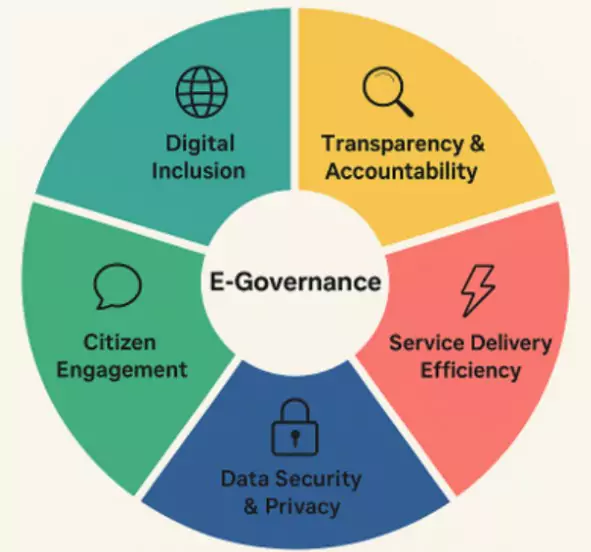The 28th National Conference on e-Governance (NCeG), held in Visakhapatnam adopted the Visakhapatnam Declaration.
About National Conference on e-Governance (NCeG)
- It is a flagship annual event on e-Governance in India.
- Co-hosted by: Department of Administrative Reforms & Public Grievances (DARPG), Ministry of Electronics & IT (MeitY), and a State Government
- Aim of the conference: To bring together government officials, industry experts, and academicians to discuss innovative and transformative approaches to ensure secure and sustainable e-service delivery in India
- Significance: Serves as a platform for policy dialogue, best practice sharing, and digital innovation showcase.
28th National Conference on e-Governance (NCeG), 2025
- Theme: “Viksit Bharat: Civil Service and Digital Transformation” with a vision of “Minimum Government, Maximum Governance.”
- National Awards: During the conference National Awards for e-Governance 2025 conferred upon 19 exemplary initiatives.
- Addition of New Category: ‘Grassroots-level initiatives in Gram Panchayats for deepening service delivery’ instituted by DARPG in partnership with the Ministry of Panchayati Raj (MoPR).
|
Key Highlights of the Visakhapatnam Declaration
- National Vision: Supports inclusive, citizen-centric, and transparent governance, aligned with “Minimum Government, Maximum Governance.”
- Rooted in Viksit Bharat 2047 vision of digital-first civil services.
- Technology-Driven Governance: Adoption of emerging technologies including artificial intelligence, machine learning, blockchain, Geographic Information System, Internet of Things and data analytics must serve as enablers of transparent, sustainable, and citizen-focused governance
- Example: Scaling up artificial intelligence-driven platforms like Digital India BHASHINI and Digi Yatra to deliver multilingual, real-time, and sector-specific citizen services
- with a focus on ethical and transparent adoption of AI.
- Replication of Successful Models: Replicating and scaling successful projects such as SAMPADA 2.0 in Madhya Pradesh, eKhata in Bengaluru, Rohini Gram Panchayat in Maharashtra, and the Drone Analytics Monitoring System (DAMS) by NHAI as proven models for technology-led service delivery
- Example: eKhata reduced property disputes in Bengaluru by 30%.
- Grassroots and Inclusive Development: Extend digital services to the North-East and Ladakh under NeSDA
- At the grassroots level, Panchayat models from Rohini, West Majlishpur, Suakati, and Palsana will be expanded nationwide, while digital literacy initiatives for women, youth, and marginalized communities aim to promote inclusivity.
- Cybersecurity and Resilience: Robust measures, including Zero-Trust architecture, post-quantum security, and AI-enabled monitoring systems, were identified as essential to building cyber resilience across sectors such as transport, defence, and citizen service platforms.
- Agriculture: Accelerate rollout of the National Agri Stack for farmer credit, advisories, and market access, supporting climate-smart farming.
- Example: Agri Stack pilots in Karnataka have improved soil-health card-based advisories.
- Collaboration and Regional Innovation Hubs: Promote government-industry-academia partnerships for scalable solutions; position Visakhapatnam as an IT and innovation hub.
- Andhra Pradesh plans special IT zones and skill training for 50,000 youth by 2030.
Six Categories and Noticeable Awardees
- Category I: Government Process Re-engineering by use of technology for Digital Transformation
- Gold (Central level initiatives) : Mining Tenement System: Digitises mining license approvals and management for faster, transparent processing.
- Gold (State/UT level initiatives): SAMPADA (Stamps And Management of Property And Documents Application) 2.0: Streamlines property and document management digitally, reducing disputes and delays.
- Category II: Innovation by Use of AI and Other New Age Technologies for Providing Citizen Centric Services
- Gold (Central level initiatives) : Digital India BHASHINI Division & Digi Yatra
- Category III: Best e-Gov Practices/Innovation in Cybersecurity
- Gold: Robust cybersecurity measures in ITOT convergence for railway systems: Ensures secure, resilient operations across rail networks.
- Category IV: Grassroot Level Initiatives for Deepening/ Widening of Service Delivery with focus on initiatives by District Level/Urban Local Bodies (ULBs) & Gram Panchayats/ Equivalent Traditional Local Bodies
- Gold – Rohini Gram Panchayat, Maharashtra: First fully paperless e-Office in the state, offering 1,027 online services, real-time grievance redressal, and ensuring 100% household digital literacy.
- Silver – West Majlishpur Gram Panchayat, Tripura: Implements citizen charter and driven digital governance, providing birth, death, marriage certificates, trade licenses, property records, and MGNREGS job cards online with monitoring for accountability and timeliness
- Jury Award – Palsana Gram Panchayat, Gujarat: Integrates platforms like Digital Gujarat and Gram Suvidha to enable QR/UPI-based property tax payments, online grievance redressal, and transparent welfare delivery for 10,000+ citizens annually.
- Jury Award – Suakati Gram Panchayat, Odisha: Digitizes essential services via OdishaOne and Seva Odisha, providing 24×7 citizen access, real-time tracking, and promoting women’s leadership and inclusive service delivery.
- Category V: Replication and Scaling up of Successful National Awarded Projects like NAeG, Prime Minister Awards in Excellence, Awards conferred by other Central Ministries by State/UT/ District
- Gold: Sampurna Shiksha Kavach: Digitised education monitoring and learning outcomes platform scaled across states.
- Category VI: Digital transformation by use of data analytics in digital platforms by Central Ministries/States/UTs
- Gold: Drone Analytics Monitoring System (DAMS) for Highway Management: Real-time highway management using drones and data analytics.
|
What is e-Governance?

- Definition: It refers to the use of Information and Communication Technology (ICT) by the government to provide services, exchange information, and interact with citizens efficiently and transparently.
- Objectives:
- Ensure citizen-centric and participatory governance.
- Improve efficiency, accountability, and transparency in public service delivery.
- Reduce administrative delays and minimise corruption.
- Key Components:
- Government-to-Citizen (G2C): Services like UMANG, DigiLocker, and online certificates.
- Government-to-Business (G2B): Digital processes for trade, taxes, and compliance.
- Government-to-Government (G2G): Inter-departmental coordination through digital platforms.
Scope of e-Governance
- Enhanced Accessibility & Scale of Services: e-Governance allows governments to deliver services at scale, reaching remote and underserved areas.
- For Example: MeitY by enabling Pan-India integration of e-Government services on DigiLocker and e-District platforms enabled citizens across all 36 States and Union Territories to seamlessly access close to 2,000 digital services anytime, anywhere.
- Higher Citizen Participation & Engagement: e-platforms enable feedback loops, online consultations, grievance redressal, and participatory planning.
- For Example: India’s E-Participation Index in 2024 was 0.6575, ranking 61st out of 193 countries, as reported in the United Nations E-Government Survey 2024
- Data-Driven & Evidence-Based Governance: Using large data sets, analytics, and AI can guide policy, monitor outcomes, and dynamically adjust programs.
- Local-Level Strengthening (Grassroots Governance): e-Governance is not just at national/state levels; local bodies (panchayats/municipalities) can deploy micro solutions for people’s needs.
- For Example: The West Majlishpur Gram Panchayat in Tripura won a national award (2024–25) for “Deepening/Widening of Service Delivery” via e-governance.
- Efficiency & Cost Reduction: e-Governance automates workflows, cutting delays and overheads
- For Example: GeM Saved Over Rs 45,000 Cr In Procurement Costs Since 2016
Key Challenges of e-Governance
- Digital Divide & Inclusivity Gaps: Rural, poor, and women often left behind due to low digital access.
- For Example: Mobile Gender Gap Report 2024 by GSMA highlights that only 75% of women in India own mobile phones compared to 85% of men, and fewer women are aware of or use mobile internet services.
- Low Digital Literacy: Mere connectivity is not enough; many citizens lack skills to use digital services.
- For Example: According to the Central Board for Workers Education, Only 38% of India households are digitally literate (61% in urban areas and 25% in rural areas).
- User-Centric Design Bias: Many e-governance projects prioritize back-end integration and technological efficiency over the usability needs of citizens, leading to platforms that are difficult for non-tech-savvy or rural users to navigate.
- For Example: The National Scholarship Portal (NSP) integrates DigiLocker for document access, but users often face issues such as broken links, complex Aadhaar queries, and limited language options, hindering accessibility for students from rural areas
- Cybersecurity & Data Privacy Risks: Rising cyber-attacks threaten trust in digital systems.
- For Example: In 2024, the BFSI (Banking, Financial Services, and Insurance,) sector witnessed a surge in cyberattacks, with global data breach costs rising to USD 4.88 million (a 10% increase from 2023) and USD 2.18 million in India.
- Fragmented & Siloed Implementation: Lack of interoperability among platforms leads to duplication.
- For Example: : State-level e-portals often don’t integrate with central systems like DigiLocker.
- Infrastructure Gaps: Power cuts, poor connectivity, and low bandwidth in Tier-2/3 towns and villages limit effectiveness.
- For Example: BharatNet Phase II completion delayed till 2025, slowing rural broadband rollout.
- Trust & Ethical Concerns: Citizens worry about misuse of personal data (especially Aadhaar-linked services).
- For Example: A multi-district investigation exposed large-scale ration fraud in UP, revealing how govt-subsidised food grains was diverted from benificiaries through Aadhaar data tampering and biometric fraud.
Way Forward for e-Governance
- Bridging the Digital Divide: Ensure universal broadband connectivity to reach all citizens, especially in rural and remote areas.
- Complete BharatNet Phase II & III to ensure universal broadband in all gram panchayats.
- Provide subsidised smartphones/tablets for students and rural households. Example: Kerala’s K-FON (Kerala Fibre Optic Network) providing free internet to poor households.Universal Digital Literacy: Enhance citizens’ ability to use digital services, including cyber hygiene, e-payments, and online governance platforms.
- Expand PMGDISHA (Pradhan Mantri Gramin Digital Saksharta Abhiyan) beyond basic skills to include cyber hygiene, use of e-wallets, and access to e-services.
- Integrate digital literacy into school curricula.
| Zero Trust Architecture (ZTA)
It is a cybersecurity framework based on the principle: “Never trust, always verify.” Unlike traditional security models that assume everything inside the network is trustworthy, Zero Trust assumes all users, devices, and applications—inside or outside the network—could be compromised. Access is granted only after strict verification. |
- Robust Cybersecurity & Data Protection: Operationalise the Digital Personal Data Protection Act, 2023 with strong enforcement.
- Regular security audits of government portals, adoption of Zero Trust Architecture.
- Example: Estonia’s model of blockchain-backed public records as a benchmark.
- Interoperability & Integration of Platforms: Avoid duplication by creating common APIs, open standards, and shared digital public goods.
- Integrate central schemes (like DigiLocker, Aadhaar, GSTN) with state portals for seamless service.
- Capacity Building of Bureaucracy: Mandatory digital governance training under Mission Karmayogi.
- Incentivise officials to adopt technology through performance-linked evaluation.
- Example: Officials trained to manage AI-driven citizen platforms like BHASHINI and Digi Yatra.
- Inclusive & Citizen-Centric Design: Develop portals and apps in local languages with voice-assist features.
- Ensure accessibility for persons with disabilities (PwDs).
- Example: UMANG app now offers services in 13 Indian languages.
- Encouraging Innovation & PPP Models: Open government datasets for startups to build value-added services.
- Expand PPP in sectors like digital health (Ayushman Bharat Digital Mission) and digital agriculture.
Key e-Governance Initiatives in India
- Aadhaar (UIDAI) (2010): A unique 12-digit biometric-based identity issued by the Unique Identification Authority of India (UIDAI), enabling Direct Benefit Transfer (DBT) and reducing the number of ghost beneficiaries.
- Digital India Programme (2015): A nationwide mission aimed at building robust digital infrastructure, delivering governance on demand, and empowering citizens through technology.
- UMANG (Unified Mobile Application for New-age Governance) (2017): A single mobile application that integrates multiple government services, addressing the challenge of fragmented portals.
- DigiLocker (2015): A secure digital wallet that allows citizens to store, access, and share official documents such as licenses, mark sheets, and certificates electronically.
- BharatNet (2011, revamped in 2015): An optical fibre broadband network connecting all Gram Panchayats, serving as the backbone for rural digital governance and internet connectivity.
- e-Courts Mission Mode Project (2007): Digital transformation of the judicial system through initiatives like electronic filing (e-filing), case tracking, and virtual court hearings.
- PMGDISHA (Pradhan Mantri Gramin Digital Saksharta Abhiyan) (2017): A rural digital literacy programme targeting six crore households, complementing BharatNet by enhancing digital skills among rural populations.
- NSDG (National e-Governance Service Delivery Gateway) (2011): A middleware platform that enables interoperability among siloed government databases and facilitates seamless service delivery.
|
Conclusion
The Visakhapatnam Declaration outlines a roadmap for inclusive, citizen-centric digital governance, leveraging AI, replicable state models, grassroots initiatives, cybersecurity, and collaborative partnerships to enhance efficiency, transparency, and accessibility, steering India toward Viksit Bharat 2047.
![]() 26 Sep 2025
26 Sep 2025


